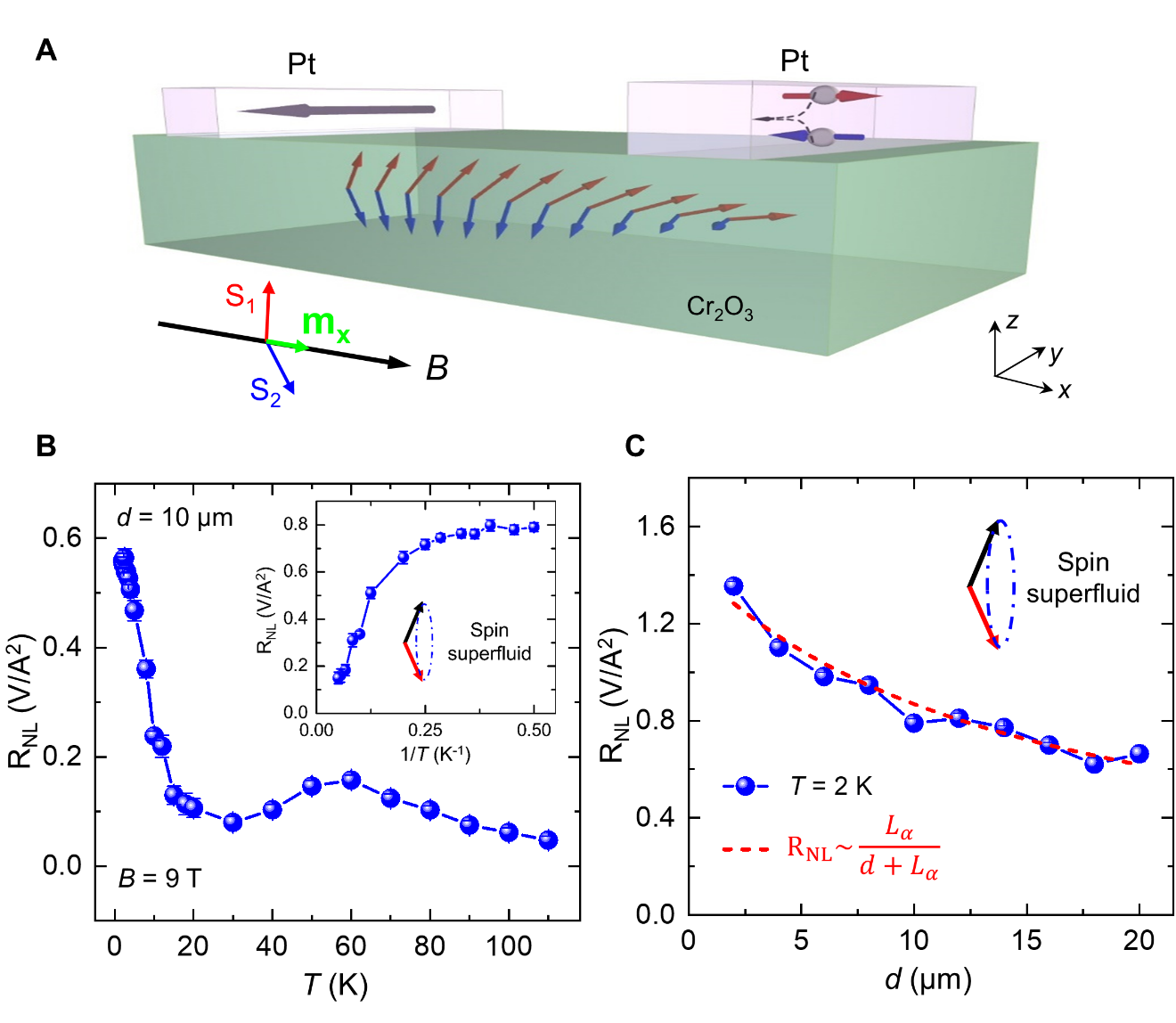Science Advances reports ICQM Faculty members Han and Xie’s experimental breakthrough towards spin superconductor
Spin superconductor is a novel emerging quantum matter arising from the Bose–Einstein condensate of spin-1 bosons. Similar to charge superconductor, it is expected to exhibit zero spin resistance and the electric Meissner effect. The zero spin resistance means the dissipationless spin current in the spin superconductor state, despite it is an insulator for charge current. The electrical Meissner effect means the expulsion of the electrical gradient in the spin superconductor states. Besides, spin Josephson effect is predicted to exist within the weak link between two superconductors with different phases. However, there is a distinct difference between a spin superconductor and a charge superconductor. The charge superconductor is formed by the Cooper pairs, while the spin superconductor arises from the Bose–Einstein condensate of spin-1 bosons with zero charge, such as electron-hole pair or magnon with spin-1. Spin superconductor has attracted a lot of attention due to its unique quantum properties. Recently, the spin transport in spin superfluid has been proposed in theory for ferromagnetic graphene and the ν = 0 quantum Hall state of graphene, ferromagnetic materials and antiferromagnetic insulators. However, the experimental observation has not been reported yet. The key challenge is the experimental observation of spin superconductor ground state and the spin transport in such state.
Recently, a major experimental breakthrough has been achieved by the ICQM team led by Prof. Wei Han and Prof. Xincheng Xie; the observation of experimental signatures of spin superfluid ground state. Using pulsed laser deposition technique, they grew single crystalline and atomically flat Cr2O3 thin films, which are antiferromagnetic and charge-insulating materials. The spin transport is performed using the nonlocal geometry; First, the spins are injected into the antiferromagnetic Cr2O3 thin films via thermal means. Then the spin information transports in the spin superfluid state, which ensures the nondissipative propogation towards the right Pt electrode. Subsequently, spins could be detected by voltage measurement across the Pt strip via the inverse spin Hall effect using standard low frequency lock-in technique (Fig. A). A large enhancement of the nonlocal spin signal is observed below ~ 20 K, and it saturates from ~ 5 K down to 2 K, which is a signature of the zero spin resistance effect, one of the main properties of the spin superfluid ground states (Fig. B). Furthermore, their experimental results show that the spins can propagate over very long distances (~ 20 µm) in such spin superfluid ground state, and the nonlocal spin signal decreases very slowly as the spacing increases, presenting an inverse relationship, which is consistent with theoretical prediction (Fig. C). This work is a major experimental breakthrough in the field of spin superconductor. The experimental demonstration of the spin superfluid ground state in canted antiferromagnet will be extremely important for the fundamental physics on the BEC of spin-1 bosons and paves the way for future spin supercurrent devices, such as spin-Josephson junctions.
This work has been published in Science Advances on April 13th, 2018 (Science Advances,4, eaat1098 (2018). DOI: 10.1126/sciadv.aat1098). The link to the paper is: http://advances.sciencemag.org/content/4/4/eaat1098.
This work is proposed and supervised by Prof. Wei Han and Prof. Xincheng Xie. The work benefits a lot from the discussion and help from Prof. Ryuichi Shindou, Prof. Jing Shi and Prof. Xi Lin. The first author is Mr. Wei Yuan, a fifth year graduate student of the International Center for Quantum Materials. Prof. Wei Han, Prof. Jing Shi, and Prof. Xincheng Xie are corresponding authors.The research is financially supported by National Basic Research Programs of China (973 program), National Natural Science Foundation of China, and the Collaborative Innovation Center of Quantum Matter.
Figure: Experimental signatures for spin superfluid ground states in canted antiferromagnet Cr2O3 via nonlocal spin transport. (A) Schematic of the nonlocal spin transport geometry for the spin transport measurement in the spin superfluid ground state. The canted magnetization direction is controlled by the external magnetic field along the x direction. In such canted antiferromagnetic configuration, the spin component (Sy + iSz) that is perpendicular to the magnetic field direction becomes coherent in the spin superfluid state. (B) The temperature dependence of the nonlocal spin signal. (C) The spacing dependence of nonlocal spin signal in the spin superfluid ground state. The red dashed line is the fitting curve based on theoretical model of spin transport in spin superfluid.
